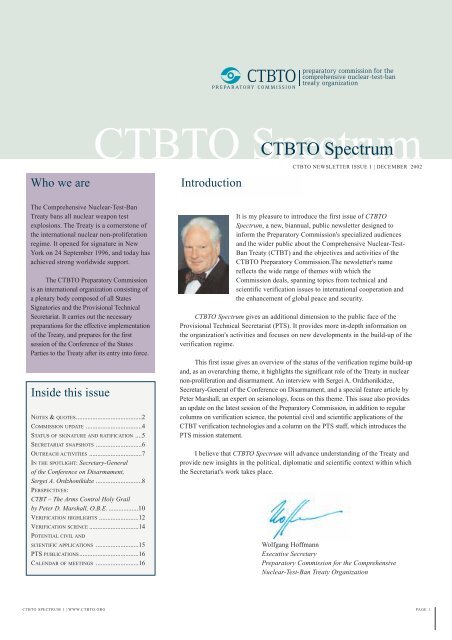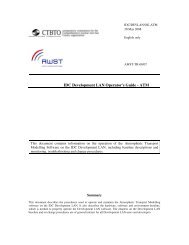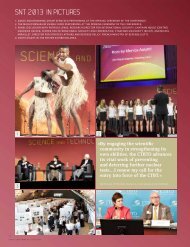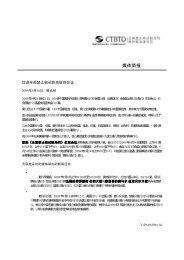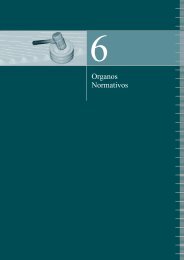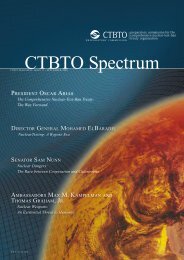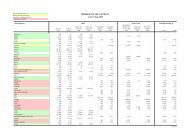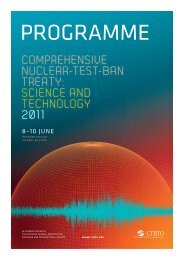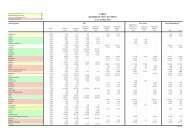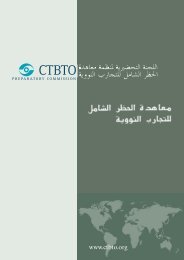CTBTO Spectrum - December 2002 Issue 1 - Comprehensive ...
CTBTO Spectrum - December 2002 Issue 1 - Comprehensive ...
CTBTO Spectrum - December 2002 Issue 1 - Comprehensive ...
Create successful ePaper yourself
Turn your PDF publications into a flip-book with our unique Google optimized e-Paper software.
<strong>CTBTO</strong> <strong>CTBTO</strong> <strong>Spectrum</strong><strong>CTBTO</strong> NEWSLETTER ISSUE 1 | DECEMBER <strong>2002</strong>Who we areIntroductionThe <strong>Comprehensive</strong> Nuclear-Test-BanTreaty bans all nuclear weapon testexplosions. The Treaty is a cornerstone ofthe international nuclear non-proliferationregime. It opened for signature in NewYork on 24 September 1996, and today hasachieved strong worldwide support.The <strong>CTBTO</strong> Preparatory Commissionis an international organization consisting ofa plenary body composed of all StatesSignatories and the Provisional TechnicalSecretariat. It carries out the necessarypreparations for the effective implementationof the Treaty, and prepares for the firstsession of the Conference of the StatesParties to the Treaty after its entry into force.Inside this issueNOTES & QUOTES........................................2COMMISSION UPDATE ..................................4STATUS OF SIGNATURE AND RATIFICATION ....5SECRETARIAT SNAPSHOTS ............................6OUTREACH ACTIVITIES ................................7IN THE SPOTLIGHT: Secretary-Generalof the Conference on Disarmament,Sergei A. Ordzhonikidze ............................8PERSPECTIVES:CTBT – The Arms Control Holy Grailby Peter D. Marshall, O.B.E. ..................10VERIFICATION HIGHLIGHTS ........................12VERIFICATION SCIENCE ..............................14POTENTIAL CIVIL ANDSCIENTIFIC APPLICATIONS ..........................15PTS PUBLICATIONS....................................16CALENDAR OF MEETINGS ..........................16It is my pleasure to introduce the first issue of <strong>CTBTO</strong><strong>Spectrum</strong>, a new, biannual, public newsletter designed toinform the Preparatory Commission's specialized audiencesand the wider public about the <strong>Comprehensive</strong> Nuclear-Test-Ban Treaty (CTBT) and the objectives and activities of the<strong>CTBTO</strong> Preparatory Commission.The newsletter's namereflects the wide range of themes with which theCommission deals, spanning topics from technical andscientific verification issues to international cooperation andthe enhancement of global peace and security.<strong>CTBTO</strong> <strong>Spectrum</strong> gives an additional dimension to the public face of theProvisional Technical Secretariat (PTS). It provides more in-depth information onthe organization's activities and focuses on new developments in the build-up of theverification regime.This first issue gives an overview of the status of the verification regime build-upand, as an overarching theme, it highlights the significant role of the Treaty in nuclearnon-proliferation and disarmament. An interview with Sergei A. Ordzhonikidze,Secretary-General of the Conference on Disarmament, and a special feature article byPeter Marshall, an expert on seismology, focus on this theme. This issue also providesan update on the latest session of the Preparatory Commission, in addition to regularcolumns on verification science, the potential civil and scientific applications of theCTBT verification technologies and a column on the PTS staff, which introduces thePTS mission statement.I believe that <strong>CTBTO</strong> <strong>Spectrum</strong> will advance understanding of the Treaty andprovide new insights in the political, diplomatic and scientific context within whichthe Secretariat's work takes place.Wolfgang HoffmannExecutive SecretaryPreparatory Commission for the <strong>Comprehensive</strong>Nuclear-Test-Ban Treaty Organization<strong>CTBTO</strong> SPECTRUM 1 | WWW.<strong>CTBTO</strong>.ORG PAGE 1
Notes & quotesUnited Nations Study onDisarmament and Non-Proliferation EducationThe United Nations Study onDisarmament and Non-ProliferationEducation was the subject of a roundtablediscussion attended by educators, students,non-governmental organizations,representatives of the United Nations(UN) system and government officials on9 October <strong>2002</strong> at United NationsHeadquarters. The UN Under-SecretaryGeneral for Disarmament Affairs,Jayantha Dhanapala, gave the openingaddress at the public launch of the study“Effective and successfuldisarmament educationrequires an active partnershipbetween governments,international organizationsand civil society.”which was later on submitted to the FirstCommittee of the 57th General Assemblyby the Deputy Minister of Foreign Affairsof Mexico, Miguel Marin Bosch. Thestudy was prepared over the past twoyears by a Group of Experts, including tengovernmental experts representing diversegeographical regions of the world, underthe chair of Miguel Marin Bosch. Theprocess of producing the study broughttogether for the first time representativesof international organizations such asUNESCO, OPCW, <strong>CTBTO</strong>, Universityfor Peace, UNIDIR, non-governmentalorganizations and educational institutions.According to the Group of Experts,the overall purpose of disarmament andnon-proliferation education and trainingis “to impart knowledge and skills toempower individuals to make theircontribution, as national and worldcitizens, to the achievement of generaland complete disarmament undereffective international control.” Thestudy assessed the existing experience inthe field, examined new aspects of themultilateral disarmament debate,questions of non-proliferation as appliedto weapons of mass destruction andsmall arms, and worked out a series ofpractical recommendations for thepromotion of disarmament and nonproliferationeducation and training.Effective and successfuldisarmament education requires an activepartnership between governments,international organizations and civilsociety, as the UN Secretary-Generalnoted in his preface to the study:“Disarmament education seeks to informand empower citizens to work with theirGovernments for positive change. I hopethat Governments, the United Nationsfamily, other international organizations,disarmament-related organizations, nongovernmentalorganizations and others ina position to contribute will do their partto sustain the process of consultation andcooperation started by the Group ofExperts, so that disarmament and nonproliferationeducation becomes anintegral – and natural – part of theeducation of the next generation.”Ministerial statementA joint statement by the ForeignMinisters of 18 countries, includingRussia, France and the United Kingdom,was issued on 14 September <strong>2002</strong>following a meeting on the margins ofthe United Nations General Assembly.The statement urges States that have notsigned or ratified the <strong>Comprehensive</strong>Nuclear-Test-Ban Treaty (CTBT) to doso as soon as possible.The Ministers said at the pressbriefing during which the statement wasissued that the early entry into force ofthe Treaty was central to nucleardisarmament and non-proliferationobjectives. “The prevention of theproliferation of materials, technologiesand knowledge which can be used forweapons of mass destruction is one ofthe most important challenges the worldis facing today. Additional internationaltensions have developed since the CTBTwas negotiated, which make entry intoforce of the Treaty...even more urgenttoday. We affirm that the CTBT has anessential role to play in strengtheningglobal peace and security”.The Ministers called on all States tocontinue the moratorium on nuclearweapon test explosions and stressed theimportance of maintaining momentum inbuilding the verification regime. Theystated that they will do all they can tomake the Treaty a focus of attention atthe highest political levels.“The prevention of the proliferation ofmaterials, technologies and knowledgewhich can be used for weapons of massdestruction is one of the most importantchallenges the world is facing today.”PAGE 2<strong>CTBTO</strong> SPECTRUM 1 | WWW.<strong>CTBTO</strong>.ORG
United Nations GeneralAssembly FirstCommittee reportThe First Committee of the 57th UnitedNations General Assembly, which coversdisarmament and international securityissues, has approved a resolution on theCTBT tabled by Australia, Mexico, NewZealand and 52 other countries, by arecorded vote of 125 in favour to oneagainst (United States). Four statesabstained (Colombia, India, Mauritius,and Syria). The resolution stresses that auniversal and effectively verifiable<strong>Comprehensive</strong> Nuclear-Test-Ban Treatyis a fundamental instrument in the fieldof disarmament and nuclear nonproliferation.It urges all States to remainseized of the matter at the “highestpolitical level” and to sign and ratify theTreaty without delay or conditions.THE UNITED NATIONS GENERAL ASSEMBLY IN NEW YORKAn omnibus resolution by the NewAgenda Coalition (Brazil, Egypt,Ireland, Mexico, New Zealand, SouthAfrica and Sweden), entitled ‘Towards anuclear-weapon-free world: the need fora new agenda’, contains a paragraphconcerning the CTBT which “underlinesthe urgency of the entry into force of theCTBT in the context of the progress inimplementing the international system tomonitor nuclear weapon tests under theTreaty.” The resolution was passed by118 votes in favour.“This Treaty is a crucialelement in the non-proliferationregime. The longer we delay itsentry into force, the greater therisk that nuclear testing willresume – and that in turn wouldmake non-proliferation muchharder to sustain.”United Nations Secretary-General Kofi Annan,Conference on Facilitating the Entry intoForce of the <strong>Comprehensive</strong> Nuclear-Test-BanTreaty, New York, 11 November 2001During the General Debate, theimportance of the conferences tofacilitate the entry into force of theTreaty (Vienna 1999, New York 2001)was underlined and concerned Stateswere called upon to sign and ratify assoon as possible. Several Statesemphasized the importance ofmaintaining a moratorium on nucleartesting. Some States also noted that“such a moratorium cannot replace thelegally binding commitment representedby signing and ratification of theTreaty.” A number of States noted that inrespect to the development of the CTBTverification regime encouragingprogress has been achieved. NinetysevenStates are on board and animpressive international system hasbeen established to deter and detectexplosive nuclear tests.<strong>CTBTO</strong> SPECTRUM 1 | WWW.<strong>CTBTO</strong>.ORG PAGE 3
Commission updateReport on theNovember <strong>2002</strong>sessionProfile of theChairperson of thePreparatory CommissionThe Preparatory Commission for the<strong>Comprehensive</strong> Nuclear-Test-Ban TreatyOrganization (<strong>CTBTO</strong>) held itsNineteenth Session on 11–15 November<strong>2002</strong> in Vienna under the chairmanshipof Ambassador Liviu Aurelian Bota ofRomania. Seventy-five Member Statesand one observer attended the session.The report of the ExecutiveSecretaryMr. Wolfgang Hoffmann, ExecutiveSecretary of the <strong>CTBTO</strong> PreparatoryCommission, reported in detail on theprogress achieved in the implementationof all Major Programmes of thePreparatory Commission. He pointedout that as of 8 November <strong>2002</strong>, 63States Signatories had paid theirassessed contributions in full and 18States Signatories had made partialpayments, which resulted in a collectionrate of 88,7% of the <strong>2002</strong> assessment ofUS$ 83 091 100.In international cooperation, Mr.Hoffmann mentioned inter alia thevoluntary contribution by theNetherlands for the year 2003 and theholding of a training course by Japan incooperation with the ProvisionalTechnical Secretariat. These voluntarycontributions by Member States arewelcomed as positive signals for thecontinuing support of ProvisionalTechnical Secretariat programmes andactivities.The plenary debateThe main focus of the plenary debatewas on budgetary issues. Member Statescongratulated Niger and Botswana ontheir ratification of the <strong>Comprehensive</strong>Nuclear-Test-Ban Treaty. SeveralMember States expressed theirappreciation for the signing of therelationship agreement between theCommission and the Agency for theProhibition of Nuclear Weapons in LatinAmerica and the Caribbean (OPANAL).Further negotiations on possiblecooperation agreements with otherNuclear Weapon Free Zoneorganizations were encouraged.ConclusionsThe Commission approved the budgetfor 2003 amounting to US$ 88 581 700.As an indication of the maturity of theorganization, the Member Statesdecided, on a trial basis, to reduce theannual number of Commission sessionsto two in 2003. Ambassador JavierPaulinich of Peru was elected as thenext chairman of the Commission forthe first half of 2003. Support wasexpressed for the convening of anotherConference on Facilitating the Entryinto Force of the <strong>Comprehensive</strong>Nuclear-Test-Ban Treaty in 2003 and forthe continuing build-up of the globalverification system.Ambassador Liviu Aurelian Bota,Permanent Representative of Romaniato the International Organizations inVienna, has served as Chairman of thePreparatory Commission for the secondhalf of <strong>2002</strong>.Mr. Bota joined the diplomaticservice in 1961 and spent several yearsas a member of the Permanent Missionof Romania to the United Nations inNew York.He also held several high-rankingpositions in the United Nations system,including Director of the UnitedNations Institute for DisarmamentResearch (UNIDIR) in Geneva, SeniorAdvisor to the Undersecretary-Generalfor Human Rights in Geneva and Headof the United Nations Mission ofObservers to Tajikistan (UNMOT) andGeorgia (UNOMIG).In 2001 he served as Chairman ofthe Permanent Council of theOrganization for Security andCooperation in Europe.PAGE 4<strong>CTBTO</strong> SPECTRUM 1 | WWW.<strong>CTBTO</strong>.ORG
ST. KITTSand NEVISTRINIDADand TOBAGOANTIGUAand BARBUDADOMINICASAINT LUCIABARBADOSSAINT VINCENTand the GRENADINESGRENADALUXEMBOURGLIECHENSTEINSANMARINOHOLYSEEMALTABOSNIAANDHERZEGOVINATHE FORMERYUGOSLAV REP.OF MACEDONIALAO PEOPLE’SDEM. REP.Ph iMICRONESIA(FEDERATED STATES OF)Treaty signatures and ratificationsARCTIC OCEANSvalbardARCTIC OCEANSEVERNAYAZEMLYAARCTIC OCEANZEMLYA FRANTSA I OSI FABeaufortSeaBaffin BayGreenlandBarents SeaNo v ayaZeml y aKara SeaLaptev SeaNOVOSIBIRSKIYEOSTROVAEastSiberianSeaHudson BayDENMARK STRAITICELANDNorwegian SeaFaerøernShetland Is.SWEDEN FINLANDNORWAYESTONIARUSSIAN FEDERATIONGilbert Is.Phoenix Is.KIRIBATIFIJIWallis &FutunaTONGATokelauSAMOAPACIFICOCEANHawaiian IslandsKiritimatiCOOK ISLANDS TahitiNIUEÎs.de la SociétéÎs.TubuaiSouth WestPacific BasinGulf ofAlaskaFrench PolynesiaÎs MarquisesQueenCharlotteIslandsÎs.TuamotuÎs.GambierPitcairnSouth-EasternPacific PlateauCANADASala y GómezEaster I.UNITED STATES OF AMERICAMEXICOCUBAJAMAICABELIZEGUATEMALA HONDURASEL SALVADOR NICARAGUAGalapagosIslandsGulf ofMexicoCOSTA RICAI.San FelixPANAMAHAITICOLOMBIAECUADORPERUI.San AmbrosiaIs.Juan FernandezBAHAMASCHILEDOMINICANREPUBLICPUERTORICOVENEZUELABOLIVIAARGENTINABRAZILPARAGUAYURUGUAYNewfoundlandNORTHATLANTICOCEANGUY ANASURINAMEFRENCH GUIANARockallIRELANDDENMARKUNITEDKINGDOMBELARUSPOLANDGERMANYCZECHREP. SLOVAKIA UKRAINEAUSTRIAREP. OFHUNGARY MOLDOVASWITZERLANDFRANCEROMANIAGHANAT OGONorth SeaNETHERLANDSBELGIUMBENINSLOVENIACROATIALATVIALITHUANIARUSSIAYUGOSLAVIAALBANIANAMIBIA ZIMBABWEBOTSWANARed SeaMOZAMBIQUESWAZILANDSOUTH LESOTHOAFRICAMADAGASCARMAURITIUSReunionKAZAKHSTANMONGOLIAMONACOBlack SeaANDORRA ITALYBULGARIA GEORGIAKYRGYZSTANSPAINPORTUGALARMENIA AZERBAIJAN UZBEKISTANGREECETURKMENISTANTURKEYTAJIKISTANAçoresSYRIANCYPRUS ARAB REP.CHINATUNISIALEBANONIRAN (ISLAMIC AFGHANISTANMadeira MOROCCOIRAQ REPUBLIC OF)ISRAELJORDANALGERIAKUWAITCanaryLIBYANIslandsNEPAL BHUTANARAB JAMAHIRIYABAHRAIN PAKISTANEGYPTSAUDIWesternQATARSaharaARABIA UNITEDARABBANGLADESHEMIRATESINDIACAPEVERDE MAURITANIAMYANMARMALIOMANNIGERERITREATHAILAND VIET NAMSENEGALCHADYEMENBay ofGAMBIABURKINASUDANSouthBengalGUINEA-BISSAU FASODJIBOUTI SocotraCAMBODIAChinaGUINEASeaCÔTE NIGERIASIERRA LEONED’ IVOIRECENTRALETHIOPIAAFRICANMALDIVESSRIBRUNEILIBERIACAMEROON REPUBLICLANKADARUSSALAMSOMALIAMALAYSIAEQUATORIALSt.Paul RocksDEMOCRATICGulf of GUINEASINGAPORECONGO REPUBLIC OF UGANDAGABONKENYATHE CONGOGuinea SAO TOMÉRWANDAFernando dePRINCIPERocasBURUNDISEYCHELLESINDONESIAUNITED REPUBLICOFChagosArchipelagoTANZANIAChristmas I.Cocos Is.Aldabra Is.Ascension I.ANGOLAFarquhar Is.MALAWIC. d’AmbreCOMOROSZAMBIAINDIANOCEANMartin VazI. da TrindadSOUTHATLANTICOCEANSt. HelenaTristan da CunhaGough I.BALTIC SEAMEDITERRANEAN SEAMOZAMBIQUE CHANNELCASPIAN SEAARAL SEAEAST INDIESSea ofDEMOCRATICPEOPLE’S REPUBLICJapanOF KOREAJAPANREPUBLICYellowOFSea KOREAEastChina SeaPHILIPPINESCelebesSeal ippi ne SeaGreat Australian BightAUSTRALIAPALAUMELANESI APAPUANEWGUINEATasmaniaSea ofOkhotskCaroline Is.MARSHALL ISLANDSCoral SeaTasman SeaSOLOMONISLANDSPACIFICNAURUNew CaledoniaSouth I.OCEANVANUATUNorth I.NEWZEALANDTUVALUFIJIFalkland/Malvinas IslandsSouth GeorgiaS.Sandwich Is.Bouvet I.Îs. Crozet193 Total States44Total Annex 2 States180165 16641 41 41 41 41 41 41160401551601491511383514031 313030120269725 Signatures10089Signatures80206913605115Ratifications401026 Ratifications2208510001996 1997 1998 1999 2000 2001 <strong>2002</strong>1996 1997 1998 1999 2000 2001 <strong>2002</strong>STATUS AS OF 28 OCTOBER <strong>2002</strong>TOTAL STATES 193SIGNATORY STATESRATIFYING STATESNON-SIGNATORY STATES44 STATES LISTED INANNEX 2 TO THE TREATY166419731273<strong>CTBTO</strong> SPECTRUM 1 | WWW.<strong>CTBTO</strong>.ORG PAGE 5
Secretariat snapshotsMission StatementThe mission of the ProvisionalTechnical Secretariat (PTS) is tosupport the efforts of the PreparatoryCommission for the <strong>Comprehensive</strong>Nuclear-Test-Ban TreatyOrganization – an independent,international, intergovernmentalorganization – in carrying out thenecessary preparations for theeffective implementation of the<strong>Comprehensive</strong> Nuclear-Test-BanTreaty and in preparing for the firstConference of States Parties to theTreaty. The Treaty bans the carryingout of any nuclear weapon testexplosion or any other nuclearexplosion.AS OF 4 OCTOBER <strong>2002</strong>, 268 STAFF MEMBER FROM 67 COUNTRIES STRIVE TO FULFIL THE PTS MISSION.THIS MULTINATIONAL STAFF COMPOSITION REFLECTS THE GLOBAL CHARACTER OF THE ORGANIZATION.The PTS works to establish aglobal verification regime to monitorcompliance with the <strong>Comprehensive</strong>Nuclear-Test-Ban Treaty. It builds,tests, and provisionally operates theInternational Monitoring System, theInternational Data Centre and therelated global communicationsinfrastructure, and prepares foron-site inspections. It provides timelydata, assessments and other productsand services to Signatory States ofthe Treaty. The PTS also conductstraining programmes and undertakesother outreach work in support of theTreaty.The international, multiculturalstaff of the PTS demonstrate thehighest standards of professionalexpertise, efficiency and integrity.THE DIRECTORS OF THE FIVE PTS DIVISIONS HAVE EITHER DIPLOMATIC OR SCIENTIFIC BACKGROUNDS.TOP ROW, LEFT TO RIGHT: PIERCE S. CORDEN (United States), Director, Division of Administration;ZIPING GU (China), Director, Legal and External Relations DivisionBOTTOM ROW, LEFT TO RIGHT: GERARDO SUAREZ REYNOSO (Mexico), Director, International Monitoring System;RASHAD KEBEASY (Egypt), Director, International Data Centre;VLADIMIR KRIOUTCHENKOV (Russian Federation), Director, On-Site Inspection DivisionPAGE 6<strong>CTBTO</strong> SPECTRUM 1 | WWW.<strong>CTBTO</strong>.ORG
Outreach activitiesThe PTS conducts a variety of activitiesfocusing on enhancing the Treatyunderstanding of decision-makers andthe general public, generating politicalsupport, encouraging internationalcooperation and building nationaltechnical capacities through training.External relationsExternal relations outreach aims toensure the entry into force of the<strong>Comprehensive</strong> Nuclear-Test-Ban Treaty(CTBT) through signature andratification by all Annex 2 States and toestablish the global verification regimein cooperation with InternationalMonitoring System (IMS) host States. Italso works to encourage universaladherence to the Treaty and to enhanceparticipation in the Commission's work.RELIMINARY SITE SURVEY OF A RADIONUCLIDE STATION IN EDEACAMEROON), AUGUST <strong>2002</strong>.The PTS furthers Treaty supportthrough bilateral and multilateralinitiatives. It organizes missions in orderto stress the political and security valueof the Treaty and to provide informationon technical implementation aspects.Joint missions between the Legal andExternal Relations Division and theInternational Monitoring SystemDivision have proven an efficient tool toachieve these goals, as they combinetechnical and political aspects of theactivities of the Commission. So far jointmissions have taken place to Cameroon(August <strong>2002</strong>) and Libya (October <strong>2002</strong>).International cooperationInternational cooperation workshops andtraining programmes also play animportant outreach role. Over 350participants from more than 130 Stateshave so far taken part in internationalcooperation workshops in venues aroundthe globe. The most recent one, in Kenyain June <strong>2002</strong>, brought together 20 Statesfrom East and Southern Africa. 25Caribbean States are expected toparticipate in an internationalcooperation workshop that will takeplace in Jamaica in <strong>December</strong> <strong>2002</strong>.The Commission also organizesexperts discussions, information visitsfor senior officials from developingStates, equipment donation to assist inthe establishment of National DataCentres (NDCs) and special trainingprogrammes for experts from developingStates.INTERNATIONAL COOPERATION WORKSHOP FOR STATESFROM EAST AND SOUTHERN AFRICA, NAIROBI (KENYA),18–20 JUNE <strong>2002</strong>.TrainingIn order to build and operate theverification system efficiently, training isessential. All three verification Divisionsoffer training courses and programmes.The IMS arranges technical trainingprogrammes for IMS station operators andstaff from NDCs. In November <strong>2002</strong>, atwo-week training course has taken placefor technical staff of NDCs from 12Member States on the use of softwarepackages to utilize International DataCentre data and products. The On-SiteInspection Division holds training coursesfor potential inspectors and workshops toaddress technical matters related to on-siteinspections.NATIONAL DATA CENTRE TRAINING COURSE FOR TECHNICAL STAFF,VIENNA (AUSTRIA), 18–29 NOVEMBER <strong>2002</strong>The PTS is currently consulting withMember States on ways to enhance itstraining programmes. At the same time, itis taking steps to establish a centralizedregistry of training information.IMS facility agreementsand arrangementsIn view of the numerous internationalagreements it concludes, the PreparatoryCommission recently acceded to the 1986Vienna Convention on the Law of Treatiesbetween States and Internationalcontinued on page 8<strong>CTBTO</strong> SPECTRUM 1 | WWW.<strong>CTBTO</strong>.ORG PAGE 7
In the spotlightSergei A. Ordzhonikidzecontinued from page 7Organizations or between InternationalOrganizations. The Commission has alarge number of bilateral agreements andarrangements with States hostinginternational monitoring facilities for theCTBT.International Monitoring System(IMS) facility agreements andarrangements are foreseen in the Treatyand are based on models adopted by theCommission to regulate theestablishment and provisional operationand maintenance of the facilities. Todate, the Executive Secretary has signed22 such agreements and arrangements onbehalf of the organization, of which 15have entered into effect and two areapplied provisionally.Negotiating IMS facilityagreements can take time. Early on itwas realized that the Commission'sprogramme of work could not wait forthem to be finalized. The practice thusevolved for host States to authorize thenecessary work by means of interimexchanges of letters, pending conclusionof the formal facility agreement. Thishas been a successful approach and legalarrangements in the form of IMS facilityagreements, or exchanges of letters, nowgovern the Commission's activities at309 of the 337 monitoring facilities in 76of the 90 host States.Mr. Ordzhonikidze,a Russian nationaland career diplomat,was appointedDirector-General ofthe United NationsOffice at Geneva inMarch <strong>2002</strong>. Healso serves as theSecretary-Generalof the Conference on Disarmament.Mr. Ordzhonikidze joined theSoviet diplomatic service in 1969 andhas held several positions at thePermanent Mission of his country to theUnited Nations in New York, includingDeputy Permanent Representative. InMoscow he served as Deputy Chief ofthe International Legal Department ofthe Foreign Ministry and Director ofInternational Organizations of theForeign Ministry. In 1999, Mr.Ordzhonikidze was appointed DeputyMinister of Foreign Affairs.Q: The <strong>Comprehensive</strong> Nuclear Test-Ban-Treaty (CTBT) was negotiated at theConference on Disarmament in Genevabetween 1993 and 1996.Where do you as the Secretary-General of this Conference place theCTBT in the overall historic context of theConference on Disarmament?A: In the nuclear context, I place theCTBT in the logical, and I hopehistorical, chain that leads fromuncontrolled nuclear proliferation tomultilaterally agreed and verifiedelimination of all nuclear weapons. Theconclusion of the CTBT in theConference on Disarmament marked thecompletion of an important step in thisprocess that essentially started with thenegotiation of the Nuclear Non-Proliferation Treaty (NPT) in one of theConference on Disarmament’spredecessor bodies.More broadly, I see the CTBT,together with the Biological WeaponsConvention and the Chemical WeaponsConvention, as a link in the fence thatwill ultimately keep out all weapons ofmass destruction. The job of theConference on Disarmament is tocontinue building this fence.Q: In the Final Declaration of theConference on Facilitating the Entry intoForce of the CTBT adopted in New Yorkon 13 November 2001, 109 ratifying andsignatory States affirmed “…that theconduct of nuclear-weapon testexplosions or any other nuclearexplosion constitutes a serious threat toglobal efforts towards nucleardisarmament and non-proliferation.”In your view, what effect will theentry into force of the CTBT have onglobal non-proliferation efforts and thedisarmament process?“The entry into force of the CTBTwould provide an immediate boostto both non-proliferation efforts andthe whole disarmament process.”PAGE 8<strong>CTBTO</strong> SPECTRUM 1 | WWW.<strong>CTBTO</strong>.ORG
A: The entry into force of the CTBTwould provide an immediate boost toboth non-proliferation efforts and thewhole disarmament process. Mostimmediately, there would be a solidguarantee against the resumption oftesting, backed up by confidence thatany illegal testing would be detected.This would deliver many governmentsthe assurance they need that the NPTregime is protected, and that theirdecision not to pursue nuclear weaponsis justified.of the Treaty can be detected in a timelyand effective manner.What political significance does theverification regime have in constrainingthe proliferation of nuclear weapons?A: The verification regime is the teethof the Treaty, and the politicalsignificance is that the teeth are sharpand strong enough to bite anyone whoconducts a nuclear text explosion. Forcountries which do not have nuclear“The verification regime is the teeth ofthe Treaty, and the political significanceis that the teeth are sharp and strongenough to bite anyone who conducts anuclear test explosion.”Secondly, entry into force wouldrestore confidence in multilateralsecurity arrangements in general, andwould boost efforts to negotiate furtherinstruments for nuclear disarmament,such as a treaty banning fissile materialproduction. I think there would also bevery positive effects in other areas, suchas biological weapons, where generalscepticism and lack of political interestis detracting from the development ofpotentially important multilateralbarriers to proliferation.Q: The world witnessed over 2000nuclear test explosions before the CTBTopened for signature on 24 September1996. CTBT's global verification regimeis the result of many years ofnegotiations led by an internationalGroup of Scientific Experts at theConference on Disarmament to ensurethat non-compliance with the provisionsweapons, there is a strong disincentive todeveloping them – essentially, there is nochance that tested and reliable weaponscould be developed undetected. For thecountries which do have nuclearweapons, there are serious constraints todeveloping and expanding their arsenals.This in turn both reduces the pressure onthem to keep up with their nuclear rivals,and represents an effective tool toprevent any non-nuclear State fromdeveloping a nuclear capability.Q: 44 States listed in its Annex 2 mustratify the CTBT before it can enter intoforce. These 44 States formallyparticipated in the work of the 1996Conference on Disarmament andpossessed nuclear reactors at that time.So far 31 Annex 2 States have ratifiedthe Treaty.What could be done in youropinion to further signature andratification of the Treaty, in particular ofthese 13 outstanding Annex 2 Stateswhose signature is still needed for theCTBT to enter into force?A: To be frank, I think the mainobstacle to entry into force of the CTBTis the lack so far of political commitmentto the concept of the nuclear-test-ban byone of the nuclear weapon States.Without leadership from all five of thepermanent members of the SecurityCouncil, we are unlikely to see the 13outstanding Annex 2 States join anytimesoon. So it is essentially a question ofbuilding political support for the test banwithin the nuclear weapon States. I thinkit is important that other, smallercountries, who rely for their security onthe guarantees contained in the NPT,make it clear how important it is to them– in pure national security terms – thatthe CTBT enters into force. Thismessage needs to be delivered throughall available channels: bilateral, regionaland multilateral.In the meantime, it is vital thatthose countries which have ratified thisinternational legal instrument, workenergetically with the <strong>Comprehensive</strong>Nulcear-Test-Ban Treaty Organization toensure that when the Treaty does enterinto force, everything will be ready andwill operate effectively. It will be all themore difficult to get the necessarypolitical support where it counts, ifinterest and support is dissipatingelsewhere.<strong>CTBTO</strong> SPECTRUM 1 | WWW.<strong>CTBTO</strong>.ORG PAGE 9
PerspectivesCTBT – The Arms Control Holy Grailby Peter D. Marshall, O.B.E.With the signing ofthe <strong>Comprehensive</strong>Nuclear-Test-BanTreaty (CTBT) on24 September 1996the most significantstep towards nuclearnon-proliferationsince the signing ofthe Nulcear Non-Proliferation Treaty wastaken. The <strong>CTBTO</strong> PreparatoryCommission which, together with itsProvisional Technical Secretariat (PTS), isto establish all the facilities specified inthe Treaty to enable States Signatories toverify compliance with the provisions ofthe Treaty, started work shortly afterwards.The CTBT contained an unprecedentedtechnical verification package, includingthe establishment of a total of 321seismological, hydroacoustic, infrasoundand radionuclide monitoring stations in 90countries – the International MonitoringSystem (IMS). In addition to theestablishment of the IMS, the PreparatoryCommission had to create an InternationalData Centre (IDC) and to define theprocess required to conduct an on-siteinspection (OSI).“The IMS is to earth scientistswhat the Hubble telescope is toastronomers or the latest atomsmasherto nuclear scientists.”The build-up of theverification regimeThe task of establishing the IMS andIDC systems, as well as the OSIprocedures, is a major engineering andlogistical challenge. Where no stationscurrently exist, a specific procedure,which can be very time consuming, mustbe followed. Agreements have to benegotiated with host States to allow PTSstaff to enter that State's territory to carryout work. Once this has been done, sitesurveys are conducted to ensure that theproposed location is adequate for thepurpose of Treaty monitoring. The nextstage is to acquire the equipment –which for each of the technologies is ofthe highest specification – and arrangefor its installation. A satellitecommunication link, part of the GlobalCommunication Infrastructure (GCI), isset up to get the data to the IDC inVienna. The IDC uses this data toprepare a bulletin of events detected andlocated for distribution within two daysto all States who wish to receive it.These bulletins can be tailor-made to aState Signatory's individual monitoringrequirements.The status of the IMSnetworkAt the present time onlypart of the IMS isoperational. The speed atwhich stations areinstalled is determined bya number of factors,including budgetaryconstraints and theavailability of specialisedequipment. What isalready clear is that the performance ofthe final IMS network for Treatymonitoring will significantly exceedthe necessarily conservative estimatesof the experts in Geneva whoestablished the original specifications.Other potential uses of theCTBT verificationtechnologiesOnce the IMS and the IDC are complete,the State Signatories will have access toa unique database. Much of this datacould be of very significant value for avariety of scientific studies which wouldbenefit mankind as well as provideassurance that the provisions of theCTBT are being adhered to. Earthquakehazard and risk assessment, monitoringof global warming, atmospheric andmeteorological studies, early warning ofthe potential dangers of volcaniceruption and studies of pollutant andbiological species are just a few of thestudies which would benefit from timelyaccess to the IMS data. The IMS is toearth scientists what the Hubbletelescope is to astronomers or the latestatom-smasher to nuclear scientists.OVERVIEW OF THIRTEEN IMS STATIONS LOCATED IN ANTARCTICAPAGE 10<strong>CTBTO</strong> SPECTRUM 1 | WWW.<strong>CTBTO</strong>.ORG
The CTBT, arms controland nuclear nonproliferationThe CTBT can make a number ofsignificant contributions to armscontrol but perhaps the mostimportant is the establishment,upon entry into force, of averifiable regime in which nuclearexplosion tests are prohibited,thus arresting the development ofnew nuclear weapons. Growinginternational concern about thethreats posed by the proliferationof weapons of mass destructionrecognizes the CTBT as a majorstep forward in reducing suchthreats.GLOBAL OVERVIEW OF THE 337 IMS MONITORING FACILITIES LOCATED IN 90 COUNTRIES“With a verifiable CTBT in forcethe nuclear non-proliferationobjectives of much of theinternational community will besignificantly strengthened. AllStates Parties are provided with areduced threat to their nationalsecurity thus making the world asafer place for humankind.”When the CTBT, often described asthe Holy Grail of arms control, wassigned, President Clinton described theevent as “the longest-sought, hardestfoughtprize in arms control.” Given thatthe first attempt to impose restraints onnuclear testing and thus control nuclearweapon development were made over 50years ago, this is perhaps a veryreasonable statement. With averifiable CTBT in force thenuclear non-proliferationobjectives of much of theinternational community will besignificantly strengthened. AllStates Parties are provided with areduced threat to their nationalsecurity thus making the world asafer place for humankind.The excellent work of the PreparatoryCommission and its PTS will, with the entryinto force of the Treaty, put anunprecedented brake on horizontal andvertical nuclear proliferation. However,there is still much work, both technical anddiplomatic, to be done before the search forthe arms control Holy Grail is over.Biographical noteAfter several years working on groundshock from underground explosions,Peter Marshall became a foundermember of the United Kingdom ForensicSeismology Research Group at AWEBlacknest and conducted research on thetechnical problems of test-banmonitoring. During more than 40 yearsof research up to his retirement in June<strong>2002</strong>, he published over 100 scientificpapers related to test-ban seismology.Peter Marshall acted as technicaladviser to successive UK Delegations ontest-ban treaty issues since 1975 andserved as Chairman of the Expert Groupduring the 1994-1996 CTBT negotiationsin Geneva. He is now enjoying a busyretirement.<strong>CTBTO</strong> SPECTRUM 1 | WWW.<strong>CTBTO</strong>.ORG PAGE 11
Verification highlightsThe <strong>Comprehensive</strong> Nuclear-Test-BanTreaty (CTBT) includes a definition ofa global verification regime to monitorcompliance with the Treaty.Establishing this regime, which must becapable of detecting nuclear explosionsunderground, in water and in theatmosphere, is the main activity of thePreparatory Commission for the<strong>CTBTO</strong>. The verification regime mustbe operational at the Treaty’s entry intoforce. The regime consists of anInternational Monitoring System (IMS)supported by an International DataCentre (IDC), consultation andclarification, on-site inspections (OSI)and confidence-building measures.IMS station statusThe global network of stations whichconstitutes the International MonitoringSystem is unprecedented in the history ofengineering. Stretching from the Arcticto Antarctica and from the Atlantic to thePacific Ocean, it covers the entire earth.In 1997 work began on the 321monitoring stations in 90countries that make up the“listening posts” of theIMS (see Figure 1).Located in some cases inthe most remote areas ofthe world, the stations useseismic, hydroacoustic,infrasound andradionuclide monitoringtechnologies.To date, site surveysfor stations have beencompleted at 87 % of the sites. 137stations (43%) are installed andsubstantially meet the Commission'sspecifications. PTS staff and numerouscontractors around the world haveworked in difficult environments toprepare the sites, construct the necessaryinfrastructure, purchase the equipmentand install and test it.Thirty-four IMS stations have so farundergone the formal process ofcertification. A certified station meets allthe requirements necessary to become arecognized part of the IMS. This includesCONSTRUCTION OF WIND-NOISE-REDUCING PIPE ARRAYS AT INFRASOUNDSTATION IS07 WARRAMUNGA (AUSTRALIA)meeting all of the technical specificationsestablished by the Commission, ensuringthat data are tamper-proof andauthenticated, and that data are sent in anuninterrupted stream to the InternationalData Centre in Vienna over an officialGlobal Communications Infrastructure(GCI) link.Following certification, the PTSbegins to pay the station operation andmaintenance costs, usually through acontract with the local technicalinstitution that has assisted with theestablishment of the station.FIGURE 1. OVERVIEW OF IMS STATION STATUS AS OF 4 OCTOBER <strong>2002</strong>PAGE 12<strong>CTBTO</strong> SPECTRUM 1 | WWW.<strong>CTBTO</strong>.ORG
IDC and GCI activitiesData collected by the InternationalMonitoring System is transmitted innear-real time via the satellite-basedGlobal Communications Infrastructureto the International Data Centre inVienna for processing and analysis.ANALYST AT THE INTERNATIONAL DATA CENTRE IN VIENNAThe GCI is the first globalsatellite communications network basedon Very Small Aperture Terminal(VSAT) technology. IMS facilities andMember States in all but near-polarareas of the world can exchange datavia their local VSAT earth stationsthrough one of the five geosynchronoussatellites. The satellites route thetransmissions to VSAT hub stations onthe ground, and the data is then sent tothe IDC by terrestrial communicationslinks. As of October <strong>2002</strong>, the GCIinstallation programme had completed125 VSAT installations out of theplanned total of 234.Between February 2000, whenMember States approved theexperimental distribution of data andproducts, until October <strong>2002</strong>, overone million such items have beendistributed to over 400 authorizedusers from 57 different Member States.Around 60,000 events such asearthquakes, mining blasts or volcaniceruptions, etc. worldwide have beendetected and reported with minimaldelay to Member States in the form ofReviewed Event Bulletins, the primaryproducts derived from IMS data. Byreviewing processed IMS radionuclidedata, the IDC has detected and reportedon nearly 200 CTBT-relevantradionuclides, or airborne radioactiveparticles. IMS data and IDC productscontinue to be successfully distributedto an ever increasing list of MemberStates.On-Site Inspectionactivities and fieldexperimentsOn-site inspections are the finalverification measure that can only becarried out once the Treaty has enteredinto force. An OSI clarifies whether anuclear explosion has taken place inviolation of the Treaty and gathers anyfacts which might assist in identifyingany possible violator.VISUAL OBSERVATIONS DURING THE ON-SITE INSPECTIONFIELD EXPERIMENT IN KAZAKHSTAN,17 SEPTEMBER–15 OCTOBER <strong>2002</strong>The major components of an OSIare an agreed Operational Manual, welltrainedinspectors and approvedequipment. On the request of anyMember State and after approval by theExecutive Council, an on-site inspectionteam of a maximum of 40 people mustbe on the territory of the Inspected StateParty within six days and at theinspection site 36 hours thereafter. Anon-site inspection may last up to 130days and cover an inspection area of upto 1000 km2.The Preparatory Commission hasgiven high priority to the elaboration ofthe draft OSI Operational Manual. Aninitial draft rolling text of the Manualwas completed in 2001 and theproduction of the draft Manual, whichmust be approved by the Conference ofthe States Parties at its initial session, iscurrently a major task of theCommission. Various training activities,workshops, equipment testing, tabletopand field experiments have taken place.To further elucidate the inspectionprocedures and technical and logisticalaspects of an OSI, field experimentswere held in Kazakhstan (1999) and inSlovakia (2001).Between 17 September and 15October <strong>2002</strong>, an extensive fieldexperiment took place in Kazakhstan totest the initial phase of an OSI. Twentysevensurrogate inspectors with OSIequipment were flown into the countryin order to find ‘evidence’ of ahypothetical nuclear event in an areacovering 400 km2. The experiment willprovide valuable data and insights forfuture OSIs.<strong>CTBTO</strong> SPECTRUM 1 | WWW.<strong>CTBTO</strong>.ORG PAGE 13
Verification scienceThe network of the InternationalMonitoring System (IMS) with itsassociated communicationsinfrastructure and the InternationalData Centre (IDC) was designed by aGroup of Scientific Experts at theConference on Disarmament in Genevato be fully capable of monitoringcompliance with the Treaty. Newresearch and improved communicationstechnology continuously strengthens andrefines the detection capabilities of theIMS. This column introduces some ofthe latest developments in the field ofverification science.The noble gasexperiment – phase IIISAMPLE OF SPECTRUM SENT VIA THE GLOBAL COMMUNICATIONS INFRASTRUCTURE TO THE INTERNATIONAL DATA CENTREThe IMS is currently carrying out the finalstage of a three-phase experiment to testnoble gas equipment. The experiment aimsto develop appropriate instrumentation fordeployment at radionuclide stations tomeasure radioactive xenon content in theatmosphere. To meet the IMS requirementsfor xenon measurements, existingmeasurement devices need to be adaptedand completely new technologiesdeveloped.In phase I, xenon measurementsystems were developed by fourinstitutions located in France, Russia,Sweden and the USA that cooperate withthe Provisional Technical Secretariat forthis purpose. During phase II of theexperiment all four noble gas systemswere located at a single laboratory to testtheir performance synchronously and toexamine the correlation of the results. Inthe current phase III of the experiment,noble gas systems are being delivered toselected sites in four different globalregions – Brazil (Rio de Janeiro), Norway(Spitsbergen), French Polynesia (Tahiti),and Southern China (Guangzhou). PhaseIII aims to assess how the systems operateunder various climatic conditions. Thesystems must demonstrate their capabilityto operate automatically and reliably in thefield. In addition, the achievement ofsecure and accurate data transmissionfrom the noble gas systems to the IDC inVienna is of particular importance forphase III.NOBLE GAS SYSTEM DEPLOYED AT RADIONUCLIDE STATIONS RN27 IN PAPEETE (TAHITI)PAGE 14<strong>CTBTO</strong> SPECTRUM 1 | WWW.<strong>CTBTO</strong>.ORG
Potential civil and scientific applicationsThe International Monitoring System usesseismic, hydroacoustic, infrasound andradionuclide monitoring technologiescapable of detecting evidence of nuclearexplosions in underground, in water andin the atmosphere in order to monitorcompliance with the <strong>Comprehensive</strong>Nuclear-Test-Ban. These verificationtechnologies, together with the data,technologies and products of theInternational Data Centre, have potentialcivil and scientific applications which canprovide significant benefits to States andthe international scientific community.How IMS seismic datacan support earthquakeresearchAccess to IMS seismic data is one of theprincipal civil benefits available toMember States. The data, from aglobally distributed network of modernseismic stations, could be used toimprove the accuracy and timeliness ofreports on potentially damaging seismicevents, especially in countries lacking anational seismic network.EARTHQUAKE AFTERSHOCK MONITORING MAP,IZMIT (TURKEY), AUGUST 1999IDC bulletins can provide reportsof the location and magnitude of largeearthquakes rapidly and could also beused to support emergency response andrelief efforts. IDC products can also beused to compute statistics on theaftershocks following large earthquakes,and to provide estimates of the size andfrequency of further aftershocks.For example, the IDC hasestimated the locations and magnitudesof several aftershocks that followed themain shock of the very destructiveearthquake that took place near Izmit,Turkey, in August 1999. More recently,the IDC prepared special event analysesfor 19 earthquakes that occurred over asix day period in January <strong>2002</strong> aroundGoma in the Democratic Republic of theCongo. These earthquakes wereprobably related to the volcanic activityobserved during the same time period.EARTHQUAKE AFTERSHOCK MONITORING MAP,GOMA (DEMOCRATIC REPUBLIC OF THE CONGO),JANUARY <strong>2002</strong>Studies of the earthquake processand studies of the structure and propertiesof the interior of the earth are the twoprincipal fields of seismological research,and IMS seismic data may also contributesignificantly to this field. High qualityseismic data is required to study thedistribution of stresses active at theearthquake source and the geometry andorientation of the causal fault. In addition,much of what is known about thestructure and properties of the interior ofthe earth has come from studies ofseismic waves passing through the earth.The IMS seismic stations providethousands of seismic waves signals perday that have traversed all parts of thesolid earth. This vast source of data canbe used by scientists to improve ourunderstanding of the earth’s interior.Vienna seminarA seminar on the potential civil andscientific applications of the four IMSverification technologies, sponsored bythe Permanent Missions of Australia,Japan, the Netherlands and the UnitedKingdom, took place at the ViennaInternational Centre on 15 October <strong>2002</strong>.The seminar focused on thetechnologies’ potential to assist nationalauthorities and researchers in diversescientific and civil fields, and was afollow-up to the senior experts’discussion on civil and scientificapplications of the CTBT verificationtechnologies held in London, 9-10 May<strong>2002</strong>. Fifteen senior experts andscientists from thirteen Statesrepresenting all six geographical regionsof the Treaty had participated in theLondon discussion.PRESENTATION BY PETER MARSHALL AT THE VIENNA SEMINAR,VIENNA INTERNATIONAL CENTRE, 15 OCTOBER <strong>2002</strong>Peter Marshall, a United Kingdomseismology expert and chairman of theLondon seminar, presented an overviewof potential IMS technology applicationsin the fields of earthquake monitoring,tsunami prediction, monitoring ofunderwater volcanoes and oceanprocesses, and meteorology relevant tocontinued on page 15<strong>CTBTO</strong> SPECTRUM 1 | WWW.<strong>CTBTO</strong>.ORG PAGE 15
continued from page 15climate change and nuclear accidents, aswell as the potential use of findingsderiving from geological mappingconducted during an on-site inspection.Mr. Marshall stressed the fact thatall potential civil and scientificapplications of International MontoringSystem technologies depend on dataavailability. The International DataCentre processes IMS raw data andmakes it available to States in the formof Event Bulletins. It is up to the Statesto make the data available for civil andscientific applications. Mr. Marshallunderlined also the importance ofPublications of the ProvisionalTechnical Secretariatsynergies with other technologies in thediscussed fields, which have not yetbeen exploited.Ambassador Liviu Aurelian Bota ofRomania, Chairman of the PreparatoryCommission, presented the concludingremarks. He encouraged further expertdiscussions, increased exchange ofinformation and technical knowledgebetween States Signatories and increasedState participation to upgrade nationaltechnological capacities.The following publications are currently available in hard copy or can be downloadedelectronically from our web site at www.ctbto.org:2001 ANNUAL REPORTof the Preparatory Commission for the<strong>Comprehensive</strong> Nuclear-Test-Ban Treaty OrganizationAVAILABLE IN A RABIC, CHINESE, ENGLISH, FRENCH, RUSSIAN AND S PANISH.BASIC FACTS: SIX BOOKLET SERIESBooklet 1: The <strong>Comprehensive</strong> Nuclear-Test-Ban Treaty (CTBT) at a GlanceBooklet 2: The Preparatory Commission for the <strong>Comprehensive</strong> Nuclear-Test-Ban Treaty OrganizationCalendar of Meetings 2003Preparatory Commission:20th Session 24 – 27 June 200321st Session 10 – 14 November 2003Working Group A:23rd Session 10 – 13 June 200324th Session 29 September – 3 Oct. 2003Working Group B:20th Session 17 Feb. – 7 March 200321st Session 26 May – 6 June 200322nd Session 1 – 12 September 2003Advisory Group:20th Session 22 – 25 April 200321st Session 27 – 30 May 200322nd Session 22 – 26 September 2003PUBLISHED BY:Public InformationPreparatory Commission for the<strong>Comprehensive</strong> Nuclear-Test-BanTreaty Organization (<strong>CTBTO</strong>)Vienna International Centre, P.O. Box 12001400 Vienna, AustriaT +43 1 26030 6200F +43 1 26030 5823E info@ctbto.orgI www.ctbto.org© <strong>2002</strong> <strong>CTBTO</strong> Preparatory Commission<strong>CTBTO</strong> SPECTRUM – ISSN: 1680-533XBooklet 3: The Global Verification Regime and the International Monitoring SystemBooklet 4: The Global Communications Infrastructure and the International Data CentreBooklet 5: On-Site InspectionsBooklet 6: Membership BenefitsAVAILABLE IN E NGLISH, FRENCH AND S PANISH.D ISCLAIMER:The boundaries and presentation of material on maps donot imply the expression of any opinion on the part of theProvisional Technical Secretariat of the PreparatoryCommission for the <strong>Comprehensive</strong> Nuclear-Test-BanTreaty Organization concerning the legal status of anycountry, territory, city or area or its authorities, orconcerning the delimitation of its frontiers or boundaries.Printed in Austria, <strong>December</strong> <strong>2002</strong>PAGE 16<strong>CTBTO</strong> SPECTRUM 1 | WWW.<strong>CTBTO</strong>.ORG


